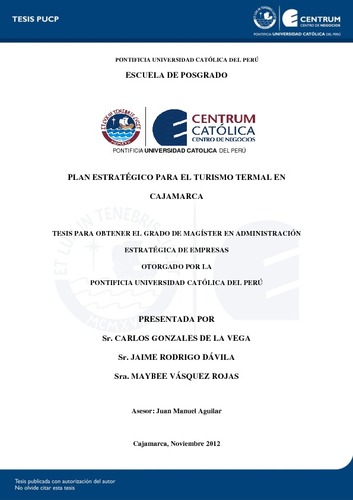| dc.contributor.advisor | Aguilar Rengifo, Juan Manuel | |
| dc.contributor.author | Gonzales De La Vega, Carlos | es_ES |
| dc.contributor.author | Rodrigo Dávila, Jaime | es_ES |
| dc.contributor.author | Vásquez Rojas, Maybee | es_ES |
| dc.date.accessioned | 2013-06-03T03:54:55Z | |
| dc.date.available | 2013-06-03T03:54:55Z | |
| dc.date.created | 2012 | |
| dc.date.issued | 2013-06-02 | |
| dc.identifier.uri | http://hdl.handle.net/20.500.12404/4589 | |
| dc.description.abstract | En el presente trabajo se realizó un análisis de la situación actual del termalismo en Cajamarca con el fin de realizar un diagnóstico tanto a nivel interno como externo identificando las fortalezas, debilidades, oportunidades y amenazas del sector; Esto nos permitió la elaboración de un plan estratégico identificando las ventajas competitivas y comparativas con las que se cuenta, proponiendo estrategias para cumplir con los objetivos a largo y corto plazo propuestos y de esta forma convertirnos en un sector eficiente, optimizando el uso del recurso termal, logrando un desarrollo sostenible, obteniendo la mayor rentabilidad, involucrando a la población y respetando al medio ambiente.
El turismo en las sociedades modernas tiene una gran importancia para el desarrollo sostenible, y si el mismo cuenta con una eficiente gestión empresarial se pueden lograr grandes impactos positivos en la economía, en la conservación del medio ambiente y en la revaloración cultural. El mercado turístico actual muestra una marcada tendencia hacia la diversificación de sus productos, capaces de atender la creciente demanda actual; como una tendencia importante encontramos que, cada día más turistas se interesan por el mantenimiento y mejora de su salud y por ello se registra un importante desarrollo en este tipo de productos turísticos, entre éstos, los que están experimentando un gran auge son las estaciones termales.
En ese sentido, el Perú y especialmente Cajamarca tiene un gran potencial para desarrollar el Turismo de salud y específicamente el termalismo, sobresaliendo por su volumen y propiedades las ubicadas en la ciudad de Cajamarca, sin embargo este recurso viene siendo utilizado de una manera deficiente, debido a una falta de infraestructura turística y al desconocimiento de las necesidades del turista termal, su nivel de satisfacción, y de las diferentes alternativas que existen para su desarrollo, agravado por una falta de productos turísticos con orientación al mercado nacional e internacional. | es_ES |
| dc.description.abstract | In this study we performed a SWOT (strengths, weaknesses, opportunities and threats) analysis of the actual state of Thermals Tourism in Cajamarca, with the objective of obtaining internal and external diagnostics of its situation. This facilitated the development of a strategic plan identifying the comparative and competitive advantages and proposing strategies to comply with the proposed short and long term objectives, and becoming an efficient industry by optimizing the thermal resource. This will allow us to achieve sustainable development and a higher margin while involving the community and conserving the environment.
Tourism in modern societies is very important for sustainable development. If it has efficient management, it could achieve a great positive impact on the economy, conservation of the environment and in our cultural value. The tourism market shows a clear tendency toward product diversification that is capable to meet current growing demands. One of our findings showed that an important trend is an increase in the number of tourists that care about maintaining and improving their health. That is the reason that this type of tourism products has shown important development, thermal stations being one of them.
In that sense, Peru and Cajamarca in particular have great potential to develop Health Tourism, especially Thermal Tourism. The ones located in the city of Cajamarca stands out due to their volume and properties, but they are being utilized in an inefficient manner. This is due to the lack of the proper infrastructure and lack of knowledge of: the needs of the thermal tourist, the tourist satisfaction levels, and the different alternatives available for their development. To make matters worse, there is a deficiency of touristic products oriented toward the national and international markets. | es_ES |
| dc.language.iso | spa | es_ES |
| dc.publisher | Pontificia Universidad Católica del Perú | es_ES |
| dc.rights | info:eu-repo/semantics/openAccess | es_ES |
| dc.rights.uri | http://creativecommons.org/licenses/by-nc-nd/2.5/pe/ | * |
| dc.subject | Turismo--Perú--Cajamarca | es_ES |
| dc.subject | Planificación estratégica | es_ES |
| dc.title | Plan estratégico para el turismo termal en Cajamarca | es_ES |
| dc.type | info:eu-repo/semantics/masterThesis | es_ES |
| thesis.degree.name | Maestro en Administración Estratégica de Empresas | es_ES |
| thesis.degree.level | Maestría | es_ES |
| thesis.degree.grantor | Pontificia Universidad Católica del Perú. CENTRUM | es_ES |
| thesis.degree.discipline | Administración Estratégica de Empresas | es_ES |
| renati.discipline | 413307 | es_ES |
| renati.level | https://purl.org/pe-repo/renati/level#maestro | es_ES |
| renati.type | https://purl.org/pe-repo/renati/type#tesis | es_ES |
| dc.publisher.country | PE | es_ES |
| dc.subject.ocde | https://purl.org/pe-repo/ocde/ford#5.02.04 | es_ES |






